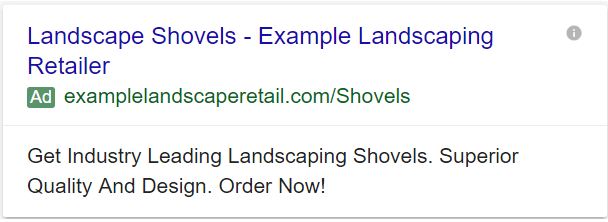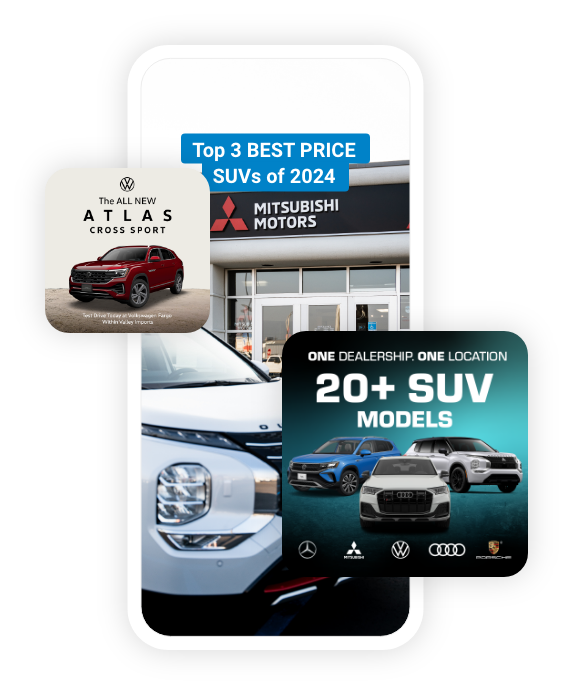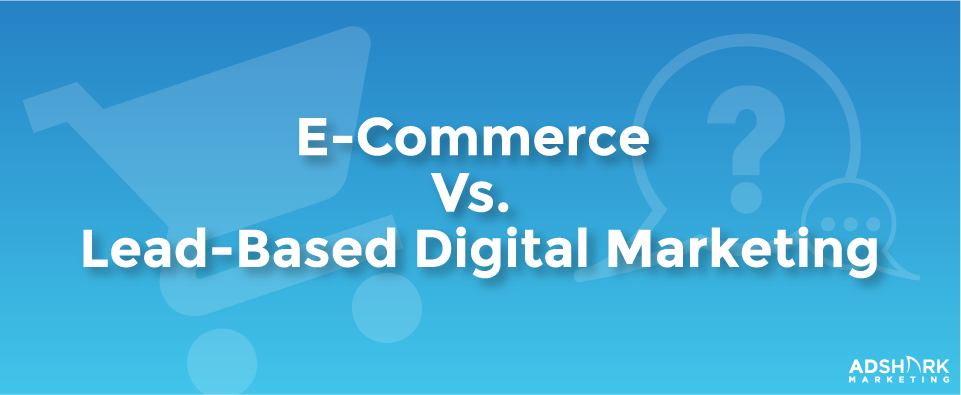E-Commerce Vs. Lead-Based Digital Marketing
Whether you are running an e-commerce store or are a lead-based business, Google AdWords is a useful tool that allows you to reach potential customers who are actively searching for what you have to offer. However, the way you set these two strategies up can differ greatly. That is why when creating a campaign you need to have a clear goal in mind.
Having a goal
A common fear people have is that they believe AdWords is only for big businesses with a lot of advertising dollars to spend. While you initially do need to set aside a budget to test what works and what doesn’t in a PPC (pay per click) campaign, once you find out what is successful, you are able to pinpoint your focus on profitable terms. After this, you can scale up budgets for profitable campaigns that prove to be getting a good return on investment and remove campaigns that are not getting the return you want.
Another common misunderstanding is that people believe PPC (pay-per-click advertising) is just for an e-commerce store. While it is true that PPC is great for e-commerce, other types of businesses can have success as well. If you run a lead based business, you obviously don’t have a product to sell on your site, but rather a service. So for this type of business, you need a different strategy that aligns with what you want to accomplish. Then you can have potential customers convert to leads instead of making a sale.
The reasoning for this is pretty simple. People use Google to find stuff they are looking for. So if you know how to be in front of them with the right message when they plan on buying or need your service, they will be more likely to choose you when the time comes.
How you advertise and what goals you have are based on what type of business you have. So we are going to go through different strategies that can be used whether you run an e-commerce business or a lead based business.
Lead-based digital marketing
Qualify The Customer
If you provide a service, PPC can still serve as an easy way to target customers when they are actively searching for your service. You can offer the best service in the world, but if people can’t find you, then you are probably losing out to your competitors.
Lead generation is more about qualifying a potential customer to be moved to the next phase of a sales process. This process can start with the customer’s initial search for a service and be continued through when they contact you via lead form, phone call, subscribe to email list, or even follow your blog. By doing this they are showing interest and might be setting up an appointment or giving you permission to contact them to then move them along further in the sales funnel towards a purchase.
Your ad campaign should always be about getting the customer to reach that conversion in the easiest way possible. From their initial viewing of your ad to every action they take on your website, they should be moving closer and closer to an action that is valuable to your business.
Example
So, for example, let’s say you are a landscaping company and you want to reach more customers who are interested in installing a patio. Obviously, a patio is not an item that you can just sell online. This would be the reason we would want to use a lead generation strategy.
It’s safe to say that a customer who is not a professional landscaper might need some assistance from a professional on what they want. This is where you are able to provide them with a solution. By filling out a contact form for a free estimate or to get a quote, you are able to have them request more information and move them along in the sales process. All that is left for you to do is move them along to the next step.
The Ad Itself
So let’s start with your first point of contact, your PPC ad in google. You want to A) serve a relevant ad to a customer who is interested in your service and B) have a relevant ad that tells them exactly what to expect with their click. Both these are important because it is the first step in qualifying your customer.
Conversion Rate Optimization (CRO)
You want your ads to be directing these potential customers to a landing page containing what they expect with as little distraction as possible. So, in this case, you would want them to request an estimate. Your landing page should have a simple contact form where they fill out their information so that you can then contact them to go about providing them with a free estimate. In this way, you are able to measure a conversion from the ad that led them to the page where they performed an action.
Measuring Results
So now how do you measure the results of your advertising efforts? For a lead-based strategy, you rely on the cost-per-conversion metric. If you are closing a good amount of sales based on the people who filled out your contact form then your campaign is a success.
What is good about lead-based is that usually when it comes to service related businesses, the value of getting a customer is really high as opposed to e-commerce where some of your items might not be very high priced and have a low-profit-margin.
E-Commerce digital marketing
While your main goal in lead-based conversions was to lead the customer to fill out a form or have them contact you, e-commerce is different in that you want to lead them directly to a purchase. So your strategy from your ad to your landing page and conversion action is going to be different. Your ads are specific and contain calls to action that emphasize buying a product now or ordering now. When they get to your landing page, they need the option to buy the item. The emphasis is on keeping their attention all along the way.
Keep The Customers Attention
PPC for e-commerce is more about steering the customer away from distractions in order to make it as easy as possible for them to make a purchase from you. Again you can have the best products in the world, but if people can’t find them, you are losing out to your competition.
This begins with the customer’s initial search for a product. For e-commerce, you want to be serving them with a relevant ad that instantly takes them where they want to go. Once they are there, you want nothing to be on their way so you can make a sale efficiently without distractions for the customer.
Example
So, for example, we’ll stick with landscaping here. Let’s say you are an online retailer of landscaping and gardening tools. You want to promote your line of industry-leading shovels. Retail products like these can be sold directly to a customer without having to go through a lengthy sales process. A lot of things for your ad are similar such as being relevant and having a clear call to action, however the ad copy and the process for how your customer buys from you are going to be different.
The Ad Itself
So for your first point of contact, the ad itself, you want to A) serve a relevant ad to a customer who is looking for your product and B) show them what to expect with a click on your ad.These two have to be present otherwise your customer doesn’t have an incentive to buy from you. The difference from your lead generation strategy is that you have different calls to action such as “Order Now” or “Buy Online” as opposed to “Get A Quote”. There are also other features such as ad extensions that are geared towards e-commerce and allow you to make your products stand out in the search results. As you can see this ad is very relevant to a customer searching for a landscaping shovel. The ad copy clearly tells them the product they are looking for, a value prop, where to get it, and what to expect with a click on your advertisement. In this case, it would be “Get Industry-Leading Landscaping Shovels” and “Order Now.”

Conversion Rate Optimization
So now that you have a well made Google ad you are halfway there. Next, you need to be sure you are not wasting your time by putting all of this effort into a well-made ad but then sending your customer to a page that is not useful to them.
If they click on your landscape shovel advertisement, they are expecting to be viewing landscaping shovels. A costly mistake would be sending them to your homepage and forcing them to navigate through your site to find shovels. A customer could easily not want to take the time to find the shovel section on your site or become irritated and leave once they see that the page does not contain what they are looking for.
In addition to having shovels, your landing page should be easy for them to navigate through and always be moving them towards a purchase without distractions. Less is generally more when it comes to e-commerce.
Measuring Results
Measuring the results of your advertising efforts in e-commerce is different from lead-based. While the cost per conversion is important, you really want to be able to know what your conversion value is relative to the cost. You want to factor in conversions and the value of those conversions so that you know that the revenue generated is worth the ad spend. If you see that revenue you are generating is considerably more than what you are putting into ad spend, you can be sure you have a strategy that is successful.
Bonus: Helpful Strategies For Both E-commerce And Lead Generation
Segment By Location
Location matters in any advertising campaign type. Let’s say your state performs well but you still want to advertise nationally. It then might be a good idea to segment out your campaigns by national and local campaigns. To do this right you have to make sure to exclude your local area in the national campaigns. It is also a good idea to exclude locations based on if they are not performing well.
Remarketing To Past Customers Or Visitors
If you want to re target past visitors searching on google, you can set up a remarketing list for search ads campaign to rank higher in the search results when those customers are searching for your product again. With a RLSA campaign, you are able to target people who visited any page on your site. You then can customize bids and ads to these visitors when they search on google or search partner sites.
The same strategy can be used with a display remarketing campaign, the only difference is you will remarket to past website visitors using image ads. Keep in mind that display campaigns generally serve a different purpose than search ads. Display ads allow you to broaden your fan base and increase brand awareness. Remarketing with display ads is useful though because you know that past website visitors are interested in what you have to offer.
Combine With A Social Media Strategy
Trying a combination of PPC and social media can be a great way to build awareness. Facebook allows you to tailor your campaigns by what objective you wish to accomplish. Whether it be building awareness for your brand, getting people to consider your business and seek more information about it, or drive people to make a purchase. You can make your Facebook advertising work hand in hand with your PPC strategy.
Facebook also has demographic targeting options that can narrow down who sees your ad. Again you have to ask what does the customer want. Is your goal to have them become aware of your brand or perform a specific action?
Doing this you can drive traffic to your site or build awareness of your brand depending on your goals.
In conclusion
To sum it up for both e-commerce and lead-based, you want to always be asking yourself what does the customer want and how can you help them accomplish that in the easiest way possible. If you are able to answer those questions and target your ads to specifically lead them to their desired action, then PPC marketing will be a success.
With more and more transactions taking place online, and many new online businesses emerging, it is good to know the best strategies so you are able to stand out against the competition. Knowing how to advertise correctly in AdWords, and accurately measuring your results with allow you to stay a step ahead of your competition.
So give PPC a try whether you are an online retailer or provide a specific service. To get started click here.
Ready To Grow?
Let's Talk!




